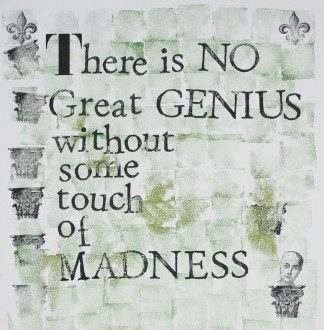Contributing Writer for Wake Up World
There has long been an association between creative genius and madness. In many respects this apparent relationship is not surprising since both involve a deviation from what is described as a ‘normal’ approach. The ability to think outside the box involves the adoption of perspectives that might not appear obvious to the average person.
Van Gogh, Sylvia Plath, Beethoven, Kurt Cobain and Robin Williams are just a few of the many creative geniuses who are believed to have suffered from some form of mental illness. When we examine the intense beauty and power of their creations, and the epic lives many of these individuals led, it can be almost instinctive to want to romanticize aspects of mental illness as it is often seen as the key to their genius. However, anyone who has experienced mental illness, either first-hand or through a loved one, knows that there is nothing romantic about the associated suffering.
Over the years mounting evidence has shown a significantly higher proportion of people who suffer from various forms of mental illness within the creative industries. One study examined 300,000 people who suffered from schizophrenia, bipolar disorder or unipolar depression, and their relatives, and found a distinct over-representation in creative professions for those diagnosed with bipolar disorder as well as undiagnosed siblings of those with schizophrenia or bipolar disorder.
Recently researchers at the Institute of Psychiatry, Psychology & Neuroscience at King’s College London, further explored this relationship. The study, published in Nature Neuroscience in 2015, was designed to establish whether genes linked to creativity could increase the risk of developing schizophrenia and bipolar disorder. Though other studies have found a link between creativity and psychiatric disorders, it had previously never been established whether genetics were responsible for this association, or whether environmental or socio-economic factors were the cause.
Researchers discovered that genetic risk scores for both schizophrenia and bipolar disorder were significantly higher in individuals defined as creative by the parameters of the study. Creative types who exhibited no symptoms of mental illness tended to have genetic risk scores that fell approximately halfway between those with disorders and the general population.
Lead author of the study, Robert Power stated:
“For most psychiatric disorders little is known about the underlying biological pathways that lead to illness. An idea that has gained credibility is that these disorders reflect extremes of the normal spectrum of human behaviour, rather than a distinct psychiatric illness. By knowing which healthy behaviours, such as creativity, share their biology with psychiatric illnesses we gain a better understanding of the thought processes that lead a person to become ill and how the brain might be going wrong. Our findings suggest that creative people may have a genetic predisposition towards thinking differently which, when combined with other harmful biological or environmental factors, could lead to mental illness.”
Though everyone has the ability to express themselves creatively, and anyone can nurture and develop these skills, this study suggests that our genetic predisposition might affect our base creativity levels as well as our tendency toward mental illness.
The Unconscious
“Crazy was such a complex concept that encompassed much of what we didn’t understand about the human mind, and the intangible aspects of our reality.” ~ C. Lavers, Jump Into the Blue
One possible explanation for why this relationship between mental illness and creativity exists is because, in both cases, there is an enhanced connection with the unconscious.
The unconscious represents a mystifying, unquantifiable space within each of us. While science is able to document some of what we are capable of at the deeper levels, there is still an enormous amount of mystery around what the unconscious actually is. It is not something that can be dissected and examined with a microscope. We may have mapped so much of our physical world, even explored deep space, but our internal world, where we return every night in sleep, is still predominantly unchartered territory.
What little that we do know about this inner realm is that it has the ability to store masses of data, way beyond any computer in existence today, and also has the ability to make leaps and connections that appear ‘genius’ to our ‘little’ conscious minds. There are countless examples of scientific and cultural breakthroughs that sprang from the unconscious in the form of dreams, visions and imaginative play. Some notable ones include: Einstein’s theory of relativity, M Theory (another theory in physics that unites versions of string theory), the periodic table, modern robotics, the sewing machine, and Mary’s Shelley’s Frankenstein.
Most of us have strong filters in place that limit the flow from the unconscious into conscious awareness. This is important because without any filters we would undoubtedly become overwhelmed in an attempt to process the vast amounts of seemingly wild and illogical content. So a plausible theory regarding the relationship between creativity and mental illness might be explained by a genetic predisposition to having a less stringent filtration system in the brain, which allows for an increased flow between the conscious and the unconscious.
An obvious question that arises from this discussion is whether we can we access the brilliance available to us from the unconscious realm, without the risk of succumbing to the debilitating qualities of mental illness? Fortunately there are many safe practices that are known to both increase our connection to the unconscious, and thus enhance our creativity, and promote our mental health at the same time.
Healthy Reality Diet
In my work with creativity, I have found that one of the most important ways we can encourage a positive experience of the unconscious is by being aware of what we absorb. In the same way that we need to be aware of what we put into our bodies, because “we are what we eat”, we benefit from being aware of what we put into our minds because our reality responds to what we feed our unconscious. When we place too much focus on the gloomy aspects of life, these qualities become emphasized in our unconscious. There’s nothing like a few hours of depressing media content, a nasty gossip fest, or a dismal, chaotic home environment to negatively taint our perspective. So make sure to include plenty of uplifting, enriching and inspiring content in all that surrounds and touches you.
Meditation
In terms of creativity, one of the ways meditation can assist our purpose is by promoting the relaxed alpha brainwaves so that they become dominant. When the alpha brainwaves are dominant we find the mental chatter that is common in the beta state is replaced with a calm, focused clarity that is conducive to finding creative solutions without being overwhelmed.
Meditation is also useful in the creative process because it is particularly good at assisting us to develop the ability to shift perspectives. It’s about stepping back from our thoughts and emotions rather than getting caught up in them, so it helps us cultivate the detachment necessary to ‘allow’ a healthy experience of the creative flow.
Grounding
A lot of techniques that assist us in creative exploration involve expanding our consciousness or shifting levels of awareness away from the rational, rigid one we normally operate from, to a looser, wilder, more flowing awareness. Because of this, I highly recommend incorporating the practice of grounding into our daily routine as a way to ensure that no matter how far we go, our feet remain firmly planted in the ground. This practice only takes a minute, but helps us to bring our focus to the here and now, soothes our nervous system, and promotes a sense of connection between our physical and non-physical worlds.
References:
Editor’s note: It is important to note that, while genuine mental illness unquestionably exists, due to conflicts-of-interest within the psychiatric and pharmaceutical industries the rates of diagnosed and medicated illnesses today far exceed the rates of genuine illness. For more information and insider perspectives on this complex issue, please see the following articles:
- Breaking Through the Stigma of Depression and Mental Illness
- The Fictions Surrounding ADHD and the “Chemical Imbalance” Theory of Mental Illness
- Brave New Medicated World: Free-Thinking and Non-Conformity Now “Illnesses”
About the author:
Christina Lavers is a writer, an artist, a creative enthusiast, and an inner world explorer. Born in Montreal Quebec, Canada, she now lives with her life partner and son in a rainforest pocket in the hills behind Coffs Harbour, NSW Australia. She spends her time playing, creating, growing and sharing.
Christina is devoted to assisting people to find and connect with their own creative magical current that flows deep within. She is now offering a comprehensive e-course designed to help people light up their world with passion and creativity. You can access Section One here for free!
Christina has also recently published her first full length book, a memoir about her wild awakening journey entitled Jump Into the Blue, and she is currently working on the next one.
“My journey has been about personal alchemy… exploring the mysteries of my soul and my environment, and learning to bring all aspects, the light and the dark, together with the transcending ingredient… love. The more I uncover and nurture the wounded aspects of my being, the more whole and grounded I feel and the more my outer world reflects the love, wonder and magic I have discovered inside”.
You can follow Christina’s work at:
Further articles from Christina Lavers:
- Dream On! Lucid Dreaming Improves Self Awareness and Metacognition
- Can Medical Marijuana Relieve Migraines?
- 10 Signs You’ve Bought Spin
- New Study Shows Regular Contact with Nature Reduces Crime, Increases Social Cohesion
- Research Shows Just 7 Minutes of Meditation Can Reduce Racial Prejudice
- Taking Care of Our Inner Tribes – Microflora, Awakening and You
- Groundbreaking Study Maps the Decline of Wild Bee Communities in the United States
- Taking Responsibility For Our Energy
- More Evidence That TV is Dumbing Us Down
- Synchrony and Exertion of Dancing Found to Encourage Social Bonding, Raise Pain Threshold
- Quitting Smoking? Try These Herbs, Tips and Incentives to Help You Succeed!

If you've ever found value in our articles, we'd greatly appreciate your support by purchasing Mindful Meditation Techniques for Kids - A Practical Guide for Adults to Empower Kids with the Gift of Inner Peace and Resilience for Life.
In the spirit of mindfulness, we encourage you to choose the paperback version. Delve into its pages away from screen glare and notifications, allowing yourself to fully immerse in the transformative practices within. The physical book enriches the learning process and serves as a tangible commitment to mindfulness, easily shared among family and friends.
Over the past few years, Wake Up World has faced significant online censorship, impacting our financial ability to stay online. Instead of soliciting donations, we're exploring win-win solutions with our readers to remain financially viable. Moving into book publishing, we hope to secure ongoing funds to continue our mission. With over 8,500 articles published in the past 13 years, we are committed to keeping our content free and accessible to everyone, without resorting to a paywall.








